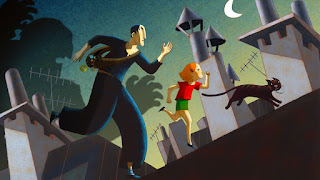Make no mistake about it. The two biggest stars of “American Hustle” are Amy Adams’s breasts. They appear in almost every scene of the film, practically naked in the plunging ‘70s necklines, and there is simply no way not to notice them. It’s a testament, therefore, to Adams’s qualities as an actress that it is possible, in the midst of all that side-boob, to notice what a tremendous performance she gives. The same kudos apply to her co-stars, Christian Bale, Bradley Cooper, Jennifer Lawrence, Jeremy Renner, and even Louis CK. It’s an all-star cast, and everyone brings their A-game, including Amy’s breasts.
Bradley Cooper plays Richie, an ambitious FBI agent who busts con-artists Irving (Christian Bale) and Sydney (Adams). In exchange for leniency, Irving and Sydney agree to help Richie entrap several other con-men, but the operation quickly spirals out of control. Richie’s ambition knows no bounds, and the team winds up giving bribes to first a well-meaning mayor (Jeremy Renner), then U.S. Congressmen, then going after the Mafia. Other reviews I have read give the impression that this is some kind of heroic operation, but the truth is, it’s all based on entrapment. Richie practically shoves the money into these guys’ hands. You can’t help feeling bad for Jeremy Renner’s mayor Carmine Polito, who really only accepts the bribe as an incidental part of securing what he thinks is an investor to help revitalize his community.
As Richie’s hubris casts the net wider and wider, Irving grows more and more uncomfortable with the operation, as well as with how much time his girlfriend Sydney is spending with Richie. Meanwhile, he has to keep his unstable wife (Jennifer Lawrence) from blowing the lid off the whole scam.
American Hustle is supposedly loosely based on a real corruption investigation from the 1970’s called ABSCAM, which was a pretty fascinating operation. As in the film, the FBI employed a con artist, Melvin Weinberg, to help them offer bribes to politicians. The operation led to the convictions of a U.S. Senator, six members of the House of Representatives, and several other officials. One Congressman, John Murtha, was not indicted, as the U.S. Attorney determined that his involvement with the agents had been largely aimed at enticing economic investment in his district, and I suspect that the movie character Carmine is based somewhat on him. Another Congressman, Senator Larry Pressler, outright refused the offered bribe and reported the incident to the FBI. When he was later referred to as a hero, his response was, “…what have we come to if turning down a bribe is ‘heroic’?”
ABSCAM was, in truth, controversial. Those convicted claimed they had been entrapped, although those defenses were ultimately rejected by the courts. Many in Congress, however, claimed that the operation was just revenge for an earlier Congressional investigation into FBI abuses. That investigation was very embarrassing for the FBI, and so ABSCAM, rather than simply being an anti-corruption operation, may have been a form of political retribution against Congress.
There are no clear heroes in “American Hustle,” either. Agent Richie is clearly a jerk and a bully. Sydney and Irving are rather sympathetic, but they are, after all, crooks. Even Mayor Carmine Polito, who is portrayed as a very decent guy, accepts a bribe and does business with the Mob out of necessity. “American Hustle” makes a point about the pervasive nature of corruption; how once it exists in a system it becomes difficult for even otherwise good people to avoid it. As Irving points out, “Some of these were okay guys just doing what they thought was business as usual.” When “business as usual” comes to mean bribes and special favors, it can be impossible to do business otherwise.
4 stars out of 5






























